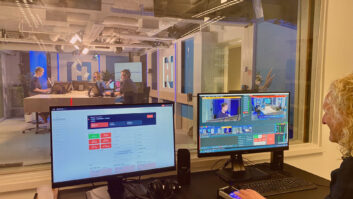LOS ANGELES�Let�s take a slight detour from thebroadcastingaspect of Digital Radio Update, so that we can take a look at another digital radio technology.� It�s probably new to most of you.
�2015 will be the year of thebeacon, as companies of all sorts begin deploying these Bluetooth nodes that (at a minimum) tell a smartphone precisely where it is so that an app can act on the specific location. Apple’s iBeacons protocol, quietly released last year as part of iOS 7, has created a cottage industry of beacon makers and test deployments in retail stores, stadiums, and more as companies explore how they might increase customer engagement, sales, and service through these devices,� says Galen Gruman, in thisarticle in Inforworld.� �Beacons use Bluetooth Low Energy (BLE), a technology built into iPhones and iPads since 2010 (and Macs since 2012) and in many higher-end Android devices since 2013. You don’t need a special reader, only the device you already have. That’s why beacons are very likely to fulfill the early location-aware dreams that RFID could not.�
Please continue read on, so that you�ll know where I�m going with this. The quoted material is from the same article.�
�At least a dozen companies market beacons that use BLE radios to detect other nearby BLE devices (such as your iPhone) and send aunique user ID (UUID) to the other device. These hockey puck-size beacons cost as little as $20, use batteries that can last a year or more, and can be affixed almost anywhere.
�The iPhone or iPad does the heavy lifting. iOS tracks the beacons it encounters and queries Apple’s UUID database to see what apps the beacon is associated to, then alerts the app (if installed on the iPhone or iPad) that a relevant beacon has been found. (The apps must implement Apple’s iBeacons APIs to communicate beacon status with the OS.)
Now here�s the payoff: �…Beacons aren’t about sending location coordinates but about self-identifying. It’s up to you what your app does once it knows you’re near a specific beacon. You decide the context you assign to that beacon.�
OK�now to my point.� As you are likely aware, many radio stations and broadcasting companies generate their own apps to connect with mobile listeners.� Is it possible that new versions of these apps can be written to take advantage of Bluetooth beacons? �Several ideas come to mind:
�������Treasure hunt.� Use a string of Bluetooth beacons to �guide� listeners along on a treasure hunt.� The �route� can go through retail outlets that are, of course, sponsors of the event.
�������Concert venues.� Station events, like concerts, seem like a great place to locate Bluetooth beacons.� Could winners for other tickets, or other prizes, be awarded this way?
�������Station remotes/pop–up tents.� How many times have you seen radio station-specific pop-up tents at events?� Would it be possible to deploy Bluetooth beacons in these circumstances, for giving away stuff?�
Let�s take some of this technology in use by our competitors, and start using it ourselves!
�
�










